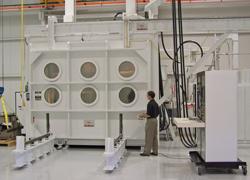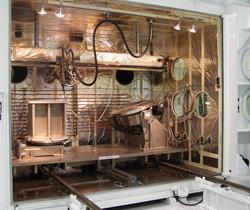- FMA
- The Fabricator
- FABTECH
- Canadian Metalworking
Categories
- Additive Manufacturing
- Aluminum Welding
- Arc Welding
- Assembly and Joining
- Automation and Robotics
- Bending and Forming
- Consumables
- Cutting and Weld Prep
- Electric Vehicles
- En Español
- Finishing
- Hydroforming
- Laser Cutting
- Laser Welding
- Machining
- Manufacturing Software
- Materials Handling
- Metals/Materials
- Oxyfuel Cutting
- Plasma Cutting
- Power Tools
- Punching and Other Holemaking
- Roll Forming
- Safety
- Sawing
- Shearing
- Shop Management
- Testing and Measuring
- Tube and Pipe Fabrication
- Tube and Pipe Production
- Waterjet Cutting
Industry Directory
Webcasts
Podcasts
FAB 40
Advertise
Subscribe
Account Login
Search
Accelerating business with EB welding
Job shop finds its niche, door to success
- By Amanda Carlson
- July 16, 2010
- Article
- Arc Welding

Ted Roark stands in front of the Sciaky VX.4 six-axis, CNC EB welding machine. The system has created new business opportunities for C.F. Roark and helped the company stay competitive.
If there’s one thing Ted Roark didn’t want to have happen, it was for the business that his father built to become ordinary.
On first glance that’s exactly how C.F. Roark Welding & Engineering Co. Inc., Brownsburg, Ind., appears. You would never guess that behind the walls of the facility, quietly tucked away from a bustling residential side street, lies technology that even Doc Brown from “Back to the Future” would envy.
Thanks to a specific vision and high-end equipment purchase, C.F. Roark is anything but ordinary. Founded in 1949, the company specializes in electron beam (EB) welding of complex, specialty parts and components for the aerospace, defense, and research industries, and in a short amount of time carved a niche as the premier EB welding firm of the Midwest.
A Leap of Faith With EB Welding
After experiencing tough economic times and watching some of its simple fabrication business head to China in the early 2000s, Roark had tough decisions to make in terms of what direction to take the company, what investments to make to keep the company relevant, and how to position it for future success.
“There were a lot of smaller family businesses around that had been bought out, merged, or had gone out of business over the years. That really challenged us to sit back and think about what we needed to do to survive in the future,” explained Roark, company president.
The answer, said Roark, came down to a simple phrase: “We can’t be vanilla.”
In other words, Roark believed that for the business to survive, it had to position itself to go after more complex fabrications that required higher skills and elaborate equipment. That realization led to the decision to make a substantial investment in EB welding equipment.
The company was already familiar with EB welding. It first made the investment in the 1970s and to this day the company still houses three manual systems—two Sciaky EB/500 MAs and a Sciaky EB/250 MA.
EB welding is a fusion process in which a high-velocity stream of electrons is focused by a magnetic coil to join the material. The kinetic energy that is produced by the electrons fuses the base metal to form the bond. The process is completed in a vacuum environment.
“One thing unique about electron beam welding is the weld itself can be very narrow,” Roark explained.

The machine’s massive size was attractive to the company, which wanted to position itself to handle complex fabrications in the aerospace and research industries.
“You can take a butt joint and the beam weld can be very narrow for that full distance. The heat-affected zone [HAZ] is very narrow, which means there is less distortion. The weld joints are usually machined joints because you have to have good fit-up. You can’t have gaps. If you have a gap, there’s nothing for the electrons to fuse to, and it almost becomes a cutting torch.”
Roark realized there wasn’t enough EB welding in the Midwest to support the midsized manufacturers, the large manufacturers, and the national science and research labs, such as Chicago-based Fermilab. Even though his company already performed EB welding in-house, he knew that to be competitive he’d have to invest in CNC machines with greater capabilities. Though the company might take a hit financially in the beginning, Roark was certain that the investment would pay off eventually if the company stuck with its plan.
The company purchased a Sciaky VX.4 six-axis, CNC EB welding system with a 138- by 108- by 107-in. footprint, one of the largest of its kind in the country, and with it, its first step away from ordinary.
“It just fits our expertise. Our niche was to go for a larger [machine] so we could do larger parts versus a smaller machine for smaller parts. It’s a niche market, and that’s the name of the game.”
The new, CNC EB welding capability opened doors to projects from Oak Ridge National Laboratory, Raytheon, Pratt & Whitney, Rolls-Royce, Bell Helicopter, USAF, and BAE Systems, just to name a few. Other projects included fabricating components for NASA’s Orion launch abort system (LAS) as well as spare parts for the military’s B-1 bomber and F110.
“A lot of our work is military-driven. In the future we don’t want to be so predominantly focused on the military side of things; we want a good diversification of commercial work in different industries. But right now the military and government work is really carrying us.”
When Science and Manufacturing Collide
One way C.F. Roark has found a way to diversify its business is through a project building niobium components for Fermilab’s International Linear Collider (ILC).
C.F. Roark partnered with Michigan-based Niowave, a company that focuses on superconducting particle accelerators, to build components for the proposed electron particle accelerator, which the lab hopes to construct in an effort to uncover smaller subdivisions of the atom, helping scientists further their research of the origins of various materials.
After finding out about the push domestic research labs were making to find U.S.-based manufacturers that could support niobium fabrication, Roark aggressively pursued the opportunity to contribute. But there were risks.
“This is all government-funded, basic physics research. It all depends on budgets and administration support. It’s all politically driven.”
C.F. Roark and Niowave were commissioned to fabricate superconducting radio frequency (SRF) cavities, or dumbbells, as Roark refers to them. The cavities are fabricated from niobium, a metal that possesses excellent superconducting characteristics at cryogenic temperatures. Each dumbbell requires 137 welds and 58 individual parts. Only one other company in the U.S. has the capacity to make SRF cavities according to Fermilab’s specifications.
Fabricating components from niobium is a delicate process. First, the dumbbells are fabricated using pure niobium. Most aerospace applications do not involve niobium alloys, so there isn’t a lot of experience dealing with pure niobium to fall back on. Second, Fermilab imposes stringent handling requirements on the niobium, meaning each component has to be kept extremely clean and cannot be touched. Third, the complexity of the component makes the initial weld development process difficult.
“For each joint you have to develop the weld, so you have to run samples. You have to figure out how the penetration will be for each joint—if it’s good, if it’s bad, or if it distorts. It’s a process.”
This past spring C.F. Roark and Niowave delivered the first two of an order of six 1.3-GHz Tesla SRF cavities that meet specifications for the ILC.
“It’s a neat sense of accomplishment. In manufacturing, at the end of the day, you produce something that goes into a project. I just enjoy seeing these components built and then reading about them as they go into use. That’s what I enjoy about manufacturing, especially a project like this.”
About the Author

Amanda Carlson
2135 Point Blvd
Elgin, IL 60123
815-227-8260
Amanda Carlson was named as the editor for The WELDER in January 2017. She is responsible for coordinating and writing or editing all of the magazine’s editorial content. Before joining The WELDER, Amanda was a news editor for two years, coordinating and editing all product and industry news items for several publications and thefabricator.com.
About the Publication
subscribe now

The Welder, formerly known as Practical Welding Today, is a showcase of the real people who make the products we use and work with every day. This magazine has served the welding community in North America well for more than 20 years.
start your free subscription- Stay connected from anywhere

Easily access valuable industry resources now with full access to the digital edition of The Fabricator.

Easily access valuable industry resources now with full access to the digital edition of The Welder.

Easily access valuable industry resources now with full access to the digital edition of The Tube and Pipe Journal.
- Podcasting
- Podcast:
- The Fabricator Podcast
- Published:
- 04/16/2024
- Running Time:
- 63:29
In this episode of The Fabricator Podcast, Caleb Chamberlain, co-founder and CEO of OSH Cut, discusses his company’s...
- Trending Articles
Sheffield Forgemasters makes global leap in welding technology

Welding student from Utah to represent the U.S. at WorldSkills 2024

Lincoln Electric announces executive appointments

Lincoln Electric acquires RedViking

Engine-driven welding machines include integrated air compressors

- Industry Events
16th Annual Safety Conference
- April 30 - May 1, 2024
- Elgin,
Pipe and Tube Conference
- May 21 - 22, 2024
- Omaha, NE
World-Class Roll Forming Workshop
- June 5 - 6, 2024
- Louisville, KY
Advanced Laser Application Workshop
- June 25 - 27, 2024
- Novi, MI


























